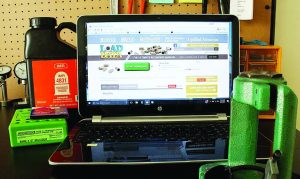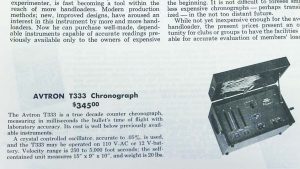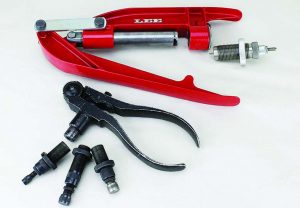by Art Merrill | Contributing Editor

The internet qualifies among the few handloading “earth shakers.”
Year’s end is the time we typically look back to gauge whether and how we’ve moved forward. We often find that a mental review of the past 12 months becomes a rumination of the many changes over our lifetime, and even further back. The value of a retrospective perspective is that we can then attempt reasonable predictions about the future rather than resorting to the divinations of casting bones or perusing goat intestines. The latter, in case you’re curious, is called, “haruspication.”
But our subject here is not haruspicy, it is handloading, and before we look to the future let’s glance behind us into the past, where we see that the pursuit is not one that features a lot of individual earthshaking changes; instead, handloading has evolved with the incremental introduction of new tools, many of them being commercial improvements on tools first cobbled together in garages and basements by inventive handloaders.
Press on
Today we accept the bench-mounted press as a given, that of course we’ve got to have one if we’re going to reload cartridges, and we almost never consider there are alternatives. Somebody in the waste-not-want-not early days of central-primed self-contained metallic cartridges first experimented with reloading brass cases and came up with the tong tool for holding dies. The go-anywhere tong tool had adequate leverage for muscle power alone to reload cartridges. It still does; the tong tool hasn’t gone away, it’s still with us in Lyman and Lee catalogs. So is the Lee Loader, which doesn’t require a press at all, just a mallet and a block of wood. Similarly, Sharp Shooter went back to the tong tool, combined with a bullet mould, with its 2015 introduction of the Rimfire Reloaders for .22LR and .22WMR cartridges.
But how many handloaders do you know who use only a tong tool for reloading? I rarely use them, and I don’t know anyone else who uses them at all. We’ve all gone to the bench-mounted press. Perhaps the biggest change we’ve seen here is the introduction of the progressive reloading press, a boon indeed to those who consume mass quantities of ammo in action shooting games.
Speed safety
The chronograph may be the most important safety device ever made for handloaders, as a real-life bullet velocity reading can preclude disaster long before it becomes apparent to the eye.
Once a very pricey, bulky, highly technical instrument found only in ballistic laboratories, after WWII demand for an inexpensive chronograph prompted inventors to bring them into the reach of Joe Handloader. The 1964 Handloader’s Digest lists the “Avtron T333” chronograph at a cost “well below previously available instruments” at $345. But that’s $2,657 in 2016 dollars —still quite expensive. Advances in electronics and digital computers since the 1970s has finally put $100 (that would have been $13 in 1964) compact chronographs in anyone’s range bag.
But even so, maybe only half the handloaders I know use a chronograph, and most days that I go to my local club range I don’t see one at all among the shooters at the benches. Instead, many handloaders simply trust in published load data and in “eyeballing” cases for pressure signs, and/or are uninterested in methodically squeezing every bit of performance out of a cartridge, and/or aren’t curious enough about handloading data to invest in the price of a chronograph and/or the effort in learning to use one.
Information, please

In 1964, chronographs cost the equivalent of $2657; today they start around $100.
We can add the internet aspect to our short list of earth shakers in handloading. Before the internet landed in every living room, lap, pocket and palm in America, acquiring handloading information was as slow as walking to the bookshelf, library, book store or gun shop, or ordering a manual through what we now disdainfully refer to as “snail mail.” Information today, in quantities too large to fully consume, is available from the internet in a fraction of a second. Much of that handloading information is valuable and interesting but some, especially from anonymous forum posters, can be wrong, ridiculous or even risky. That said, other posters in a particular thread usually challenge those kinds of posts or correct bad information and typos. Still, it’s a caveat emptor world and you accept additional risk without recourse when using data from any source that hasn’t carefully analyzed ammo under controlled laboratory conditions.
Several major bullet and powder manufacturers post free load data online; just like printed load data manuals, each have their advantages and limitations, the latter being a focus, understandably, on the products of that particular manufacturer. That is, bullet manufacturer data features only their own brand of bullets and list many different powders, while powder makers list only their powders but feature a wide variety of bullets. These websites sometimes feature an “interactive” calculator wherein you plug in some starting point data—say, bullet weight and powder—and the calculator delivers up a powder charge weight and resulting velocity. Examples are Hodgdon (with a powder focus) at hodgdonreloading.com and loaddata.com. The latter requires an annual $35 membership fee but, unencumbered by any brand loyalty, the publisher (Wolfe, which also publishes well-respected Handloader magazine) list a staggering 312,000+ handloads, literally exponentially more than any other resource, with more added continuously.
Online ballistic calculators for calculating trajectory, bullet drop and wind deflection are also available; some are free, some feature only a specific maker’s bullets (fair enough), some are simple and others more complex and detailed. JBM Ballistics offers use of an excellent online calculator for free at http://www.jbmballistics.com/cgi-bin/jbmtraj-5.1.cgi and lists bullets from Aguila 29-gr. .223 thru Woodleigh 1000-gr. .700 caliber.
The internet is a fabulous tool for quickly finding other resources, especially when seeking dies, moulds, brass or bullets for long-obsolete cartridges. Beyond the old stuff, at our end of history’s time scale, when manufacturers introduce a brand new product they quickly post information on the internet to get the word out so that we don’t have to wait weeks or longer to examine it. Hornady, for example, posted “New for 2018” back in October, 2017.
Unlike the tong tool and the chronograph, every handloader I know (except for one crusty old timer who eschews even a cell phone) uses the internet. It’s an enormous library of old and new cartridge and handloading info that takes up almost no space in the home. Truly, its impact on handloading equals that of the chronograph and the bench-mounted reloading press.
So, what’s next?
Political reloads?

Early reloading tools are still with us. Below, the Lyman 310; above, the Lee hand Press is a variation on the theme.
Looking forward, it appears politics will continue to play a part at our loading bench. Politics impacts reloading in direct and indirect ways. We’ve seen the 1970s federal ban on lead shot for waterfowling expand to a number of states also prohibiting lead shot for upland bird hunting. That, in turn, has expanded into a recent California ban on lead bullets for some big game hunting. The impetus behind the bans are environmental concerns over lead poisoning of wildlife; because ethical hunters are also conservationists, we can expect many hunters to voluntarily (as they do here in Arizona condor country) choose lead-free bullets for some big game hunts. As sentiment continues in that direction, whether or not there eventually comes a nationwide ban on lead in hunting bullets, we’ll see an increase in load data for these lead-free bullets as more hunters choose them.
We may see the day of the “Suppressors Only” indoor shooting range. Almost overnight, firearms suppressors have become a major new focus in both hunting and politics. At least, they have in the US; in Europe suppressors have been a non-issue and are considered a courtesy to others when hunting. Here, movies have long equated suppressors with criminals and assassination, and we’re fighting yet another uphill battle against ignorant fears based upon fictions as we work to reduce unnecessary regulation of suppressors. The outlook is hopeful enough that manufacturers are already offering subsonic rimfire and centerfire ammunition, necessary for suppressors to perform most effectively. Data for subsonic handloads are beginning to trickle into the mainstream, as well, and we’ll see that increase as suppressors become more popular.
Closer to the present, manufacturers will present their new wares for 2018 at the SHOT Show next month. We’re sure to see more improvements to existing handloading tools, and maybe —just maybe—2018 will be the year something will shake the earth under our avocation.



